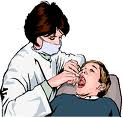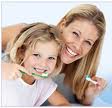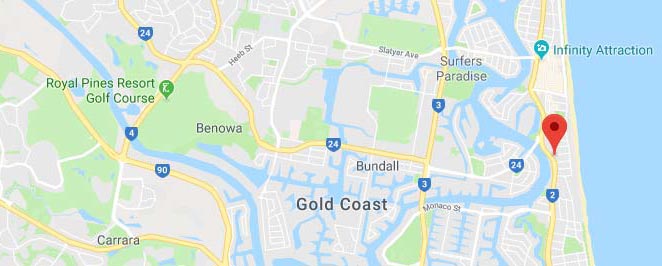Your child’s first teeth will begin coming in between three and sixteen months (usually around six months). The two bottom front teeth will be the first to come in and this will be followed by the four upper teeth in four to eight weeks. The timing of the eruption of the first tooth is largely influenced by genetics, so if there is a family history of getting the first tooth late, then your child will probably also get his first tooth late.
 Your child will continue to get new teeth until he has all twenty of his primary teeth when he is three years old, with most children getting about four new teeth every four months. Children begin shedding their first teeth when they are around 6-7 years old, and this process is complete with the loss of the 2nd molars when he is about 11-13 years old.
Your child will continue to get new teeth until he has all twenty of his primary teeth when he is three years old, with most children getting about four new teeth every four months. Children begin shedding their first teeth when they are around 6-7 years old, and this process is complete with the loss of the 2nd molars when he is about 11-13 years old.
Permanent teeth begin erupting at around 6-7 years of age and continues until your child gets his third molars (or wisdom teeth) when he is about 17-22 years old.
In most children, teething only causes increased drooling and a desire to chew on hard things, but in some it does cause mild pain and irritability and the gums may become swollen and tender. To help this you can vigorously massage the area for a few minutes or let him chew on a smooth, hard teething ring. Teething should not cause fever, diarrhea, sleeping problems or diaper rashes. While most children do not need teething gels or treatment with Tylenol for pain, you can use these products if necessary.
When should I begin cleaning my child’s teeth?
Once your child’s teeth begin erupting, you can begin cleaning them by wiping them with a moist washcloth. As your child gets more teeth, you can begin to use a soft child’s toothbrush. You should use just a pea-size amount of a fluoride toothpaste or a non-fluoride toothpaste (like Baby OraGel) until your child is able to spit it out (too much fluoride can stain their teeth).
When should I take my child to the dentist?
 According to the recommendations, the first visit to the dentist should be ‘when the first tooth comes in, usually between six and twelve months of age.’
According to the recommendations, the first visit to the dentist should be ‘when the first tooth comes in, usually between six and twelve months of age.’
The Australian Academy of Pediatrics used to recommend that the first visit to the dentist be at three years of age. Now, because so many children have cavities by the time they start kindergarten, the AAP states that high risk children should see a dentist six months after their first tooth erupts or before they are 12 months old.
In addition to looking for and preventing problems, an early visit to the dentist can help educate you about your child’s oral health and proper hygeine. If your child is not high risk, your Pediatrician should begin oral health evaluations by six months of age.
So when should the first visit be?
 If your child doesn’t have any risk factors for developing cavities, such as sleeping with a cup or bottle or walking around all day with a cup of juice, and if his teeth seem to be developing normally, then you can probably wait until your child is older and just ask your Pediatrician to check his teeth at each well child visit.
If your child doesn’t have any risk factors for developing cavities, such as sleeping with a cup or bottle or walking around all day with a cup of juice, and if his teeth seem to be developing normally, then you can probably wait until your child is older and just ask your Pediatrician to check his teeth at each well child visit.
Another risk factor for getting a lot of cavities can include having a mother with a lot of cavities. Also, kids with special health care needs, later order offspring, and children from families of low socioeconomic status, are considered to be at risk for cavities and should likely see a dentist early
If your child has any problems, such as staining of his teeth, crowding or abnomal tooth development, or if he has any risk factors for developing cavities, then he should see a dentist earlier. You may also want to see a dentist if your child has any persistent habits, such as sucking his thumb or using a pacifier as a toddler or grinding his teeth at night (bruxism).
If your family dentist tells you that your first visit should be delayed until he is four or five years old, then you may want to see a Pediatric dentist for the first few years.
Does my child need fluoride supplements?
In general, yes. All children need supplemental fluoride after they are six months old to help prevent cavities. For most children, they can get this fluoride from the water they drink, if they are in an area where the city water supply has an adequate amount of fluoride in it (greater than 0.6 ppm), and they are drinking tap water.
Sources of water that generally don’t have enough fluoride include well water and filtered or bottled water, although some brands of bottled water (or nursery water) do have fluoride added to it. Also, commercially prepared pre-mixed infant formulas do not contain an adaquate amount of fluoride, so consider using a powder or concentrated formula and mixing it with tap water, supplement your infant with extra tap water, or talk to your Pediatrician about giving fluoride supplements.
If you only use a water filter pitcher or a counter top filter, it likely doesn’t remove the fluoride from the water. Other types of water filters might though. If you have any doubt, check with the filter’s manufacturer.
It is in general better to have your child drink water that is supplemented with fluoride instead of giving extra fluoride drops or supplements. Too much fluoride can cause fluorosis, which is permanent white to brown discoloration of the enamel of the teeth. It is easier to get fluorosis if you are giving your child fluoride drops and he is still getting fluoride from his diet. Why are my child’s teeth stained?
In addition to intrinsic staining, that can be caused by fluorosis, blood and bile pigments, inherited defects of dentin and enamel, medications (especially tetracycline), and trauma, teeth can also be extrinsically stained from bacteria and food stains.
Does my child need sealants?
Sealants are usually applied to the back teeth to help protect the grooves and pits of these teeth that can be hard to clean and are prone to developing cavities. A sealant is a plastic material that is applied to the teeth, hardens, and provides a barrier against plaque and other harmful substances. Sealants should be applied to the 1st and 2nd permanent molars and appropriate premolars as soon as possible after they erupt (usually after 6 years of age).




